Foreign Insulators
by Marilyn Albers
Reprinted from "Crown Jewels of the Wire", October 1999, page 5
NEW INSULATOR STYLES EMERGE FROM FRANCE
The precious little Munchkin you see in the photo below to the left of CD 500
from Uruguay is just one of two examples known at the time of this writing. Both
were found in France and sent by a good friend to collector Bernie Warren, who
hopes for a CD number as soon as Woody (N.R. Woodward) is able to learn more
about its use in service. In the meantime I wanted to show it to all of you so
you can marvel right along with me at this tiny insulator that stands only 1-5/8" tall with a base diameter of just 1-3/8". The name "FOLEMBRAY" is embossed down low on the skirt of the insulator with no style number
on the opposite side as found on every other Folembray style we have seen. In
place of horizontal threads, there are four vertical bars evenly spaced up
inside the pin hole to secure a cemented metal pin to the insulator. The color
of glass is a pretty yellow green. What a jewel!!
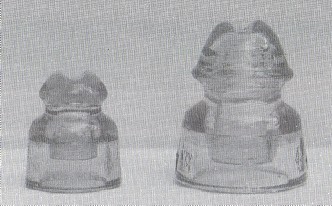
World's tiniest pin-type insulator.
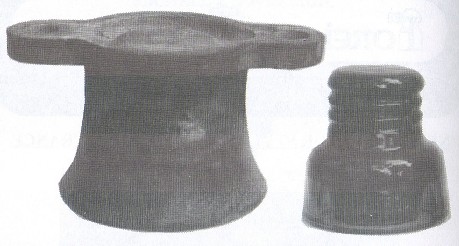
A cast iron shell with a glass insert.
This two part insulator was acquired by Jim and Lis Bergman during one of
their recent trips to France. As you can see in the photo above, the glass
insert has been removed from the cast iron shell. This part is only 2-3/4"
tall with a base diameter of 2-5/8". "ISOREX" is embossed on one
side of the glass and the style number "1043" appears in the same
location on the opposite side. The iron shell is 5-1/8" tall with an arm
span of 5-3/4" and a base diameter of 4". It was probably supplied by
Siemens Brothers of Germany. The horizontal ribs you see on the outside of the
insert were intended to secure it to the cement up inside the iron shell and the
5 mm threads in the pin hole of the glass indicate that the entire unit was to
be mounted on a threaded metal pin. Jim tells me these insulators were used on
trolley lines. I suspect the vertical holes in the two metal arms were designed
to secure necessary wires. Perhaps after his next trip to France he will also be
able to tell us the purpose of the round depression on the top of the iron
shell. Woody will need more information on this insulator before making a
decision, but in the meantime isn't it an interesting combination? I would like
to have one for my own collection, wouldn't you?
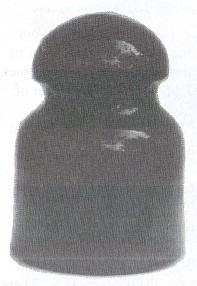
An embossing variation for CD 445.
The only other CD 445' s I have seen were made and used in Romania with
identifying trademarks to indicate which of the local factories produced them.
The particular example you see above is embossed "ISOREX" on the front
skirt with "233" on the opposite side. This is a new embossing
variation for CD 445. Almost all of the Romanian insulators were made in either
bright green or light aqua glass but this new "ISOREX" variation is in
a dark shade of yellow green. The interesting thing about this piece is that the
threads in the pin hole are only 2.7 millimeters, which is about 10 threads per
inch, as opposed to the 4 mm threads found in the Romanian insulators.
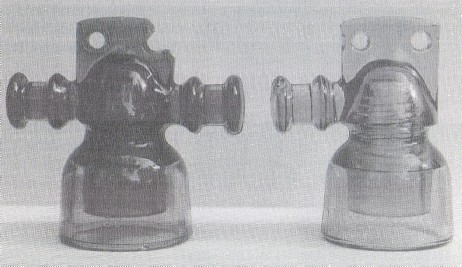
Two new CD's - CD 687.1 and CD 686.4.
The insulator on the left in the photo has been classified as new CD 687.1.
This style has been referred to by collectors as the "Robot". It is a
fuse insulator that Jim found in damaged condition but not having another like
it, he brought it home for his collection. I'm sure he will be able to replace
it for a better one the next time he goes to France. This one measures 4-1/2" in
height, has a base diameter of 2-1/2", and there are 4 mm threads in the pin
hole. The arm span measures 4-1/2" from tip to tip. "L'ELECTRO
VERRE" is embossed low on the front skirt with the number "86"
appearing on the other side. The color of glass is bright green.
The one armed
insulator you see to the right in the photo is a variation of CD 686.4, a number
which was previously assigned to a similar one armed style with the same basic
measurements 'except that it was made by Folembray of France. The example you
see here in green aqua has the "L'ELECTRO VERRE embossing on the skirt and
the number "85" in the same location on the opposite side. There are 4
mm threads in the pin hole. This insulator was also used as a fuse insulator.
The arms on these pieces are very prone to damage so if you own one, or hope to
own one, put them in a safe place away from small children and frisky pets.
I've been staring in absolute awe at this next insulator which Woody has classified
as new CD 485. It is indeed a beautiful "hunk" in emerald
green glass that even a non-collector would appreciate. "L' ELECTRO
VERRE" is embossed on the front of the skirt with the number
"147" on the rear skirt. This thing weighs in at 2-1/2 lbs. so it was obviously made for use on high tension power lines. It is 4-
5/8" in height and has a base diameter of 4- 7/8". The large pin hole
measures 1- 5/8" across the widest part and is lined with 6 mm threads, so I
suspect a very thick metal pin was once cemented up inside the insulator to
support all that weight.
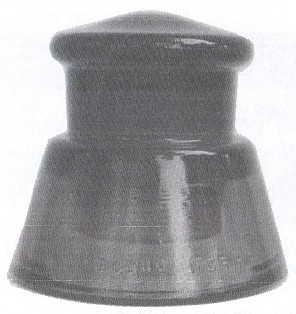
New CD 485 with a most unusual profile.
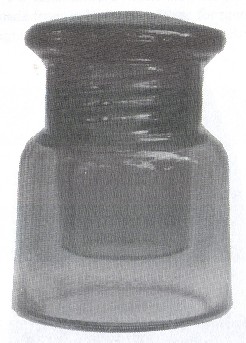
New CD 480, second cousin to a door knob.
CD 480 is another beautiful insulator in yellow green glass made by
Folembray. The company name is embossed on the front skirt with "NO. 102" in the same location on the opposite side. This insulator is 4-5/8" tall and has a base diameter just a couple whiskers under 3-1/2". Here
again the 1-1/2" diameter of the pin hole and the 6 mm threads that circle that
space would have required a thick metal pin and plenty of cement to handle the
job the insulator was designed to do.
This CD 553 ISOREX in beautiful dark olive
green is a familiar style that has already been published in "Glass
Insulators from Outside North America" and the accompanying "Price
Guide". It is 5-1/8" in height with a base diameter of 3-3/4". There
are 5 mm threads in the pin hole. This particular example was acquired by Bernie
Warren during one of his recent trips to France. The "ISOREX"
embossing on the front skirt is good and clear and properly spelled but the
style number on the opposite side is incorrect. It should have been
"235" instead of "325". After close examination of this
piece, N.R. Woodward has concluded that the engraver at the ISOREX plant must have carelessly transposed
the numbers. As I write, I'm looking at an identical ISOREX insulator that has
the correct style number "235". Now that engraving errors are becoming
more and more collectible, Bernie's insulator is probably worth more to him now
than if it had been properly marked. There may be duplicates out there in
"insulator-dom" so watch for them!
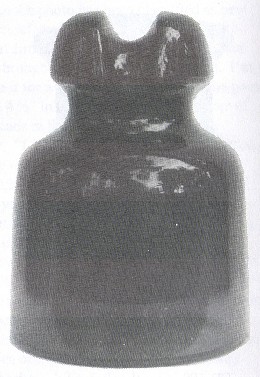
CD 553 ISOREX with an embossing error.
CD 588.2 is another newcomer produced by Folembray. It measures 5-3/8"
in height and has a base diameter of 3-1/2". "FOLEMBRAY" is embossed on
the front skirt with "NO 234" over "2A" on the opposite
side. This particular example has exactly the same profile as CD 588, which is a
smaller version included as a new style in one of my Crown Jewels articles some
time ago. The only difference between the two is that this new CD 588.2 is 1-1/8"
taller and 3/8"wider than the CD 588. Both insulators were
made from Folembray's recipe for pretty yellow green glass. Back lighting makes
them especially attractive.
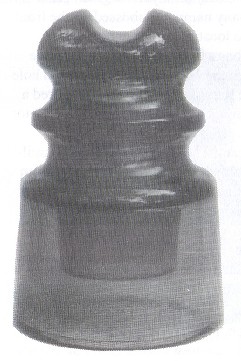
New CD 588.2.
New CD 536.4 is made of emerald black glass and weighs just an ounce over 3-1/2 pounds! I wonder how in the world Jim and Lis managed to get it home safely.
It is very, very heavy! "ISOREX" is embossed on the front skirt with
"236 BIS" in the same location on the opposite side. This insulator is
6-3/8" tall with a base diameter of 4-1/4". Here again CD 536.2
"ISOREX // 234 BIS" is a smaller version of the same style which has
already been published in G.I.F.O.N.A. - same color, same profile except it is 1-1/8" shorter and
3/4" narrower than the 536.4. This one I can lift.
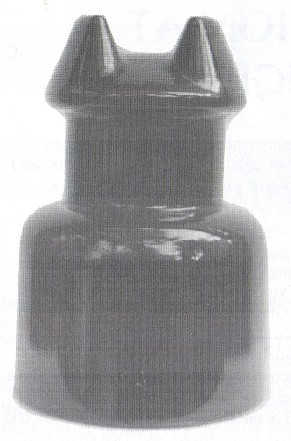
New CD 536.4.
Many thanks to Bernie Warren for loaning the tiny, tiny little FOLEMBRAY
insulator and the "ISOREX // 325" with an embossing error. The eight
remaining insulators were sent to me by Jim and Lis Bergman, who were kind
enough to trust me with so many of their new found treasures. This kind of
support keeps the foreign insulator articles coming!
| 